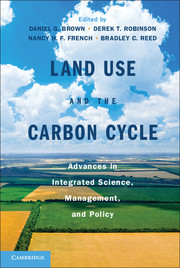Book contents
- Frontmatter
- Contents
- Chapter Authors and Affiliations
- Acknowledgments
- Acronyms
- Part I Introduction
- Part II Measurement and Modeling
- Part III Integrated Science and Research Applications
- Part IV Land Policy, Management, and the Carbon Cycle
- 13 Managing Carbon: Ecological Limits and Constraints
- 14 Effects of Wildland Fire Management on Forest Carbon Stores
- 15 Soil Carbon Dynamics in Agricultural Systems
- 16 U.S. Policies and Greenhouse Gas Mitigation in Agriculture
- 17 Opportunities and Challenges for Offsetting Greenhouse Gas Emissions with Forests
- 18 Opportunities and Challenges for Carbon Management on U.S. Public Lands
- 19 Design and Planning of Residential Landscapes to Manage the Carbon Cycle: Invention and Variation in Land Use and Land Cover
- Part V Synthesis and Future Directions
- Index
- Plate Section
- References
19 - Design and Planning of Residential Landscapes to Manage the Carbon Cycle: Invention and Variation in Land Use and Land Cover
Published online by Cambridge University Press: 05 February 2013
- Frontmatter
- Contents
- Chapter Authors and Affiliations
- Acknowledgments
- Acronyms
- Part I Introduction
- Part II Measurement and Modeling
- Part III Integrated Science and Research Applications
- Part IV Land Policy, Management, and the Carbon Cycle
- 13 Managing Carbon: Ecological Limits and Constraints
- 14 Effects of Wildland Fire Management on Forest Carbon Stores
- 15 Soil Carbon Dynamics in Agricultural Systems
- 16 U.S. Policies and Greenhouse Gas Mitigation in Agriculture
- 17 Opportunities and Challenges for Offsetting Greenhouse Gas Emissions with Forests
- 18 Opportunities and Challenges for Carbon Management on U.S. Public Lands
- 19 Design and Planning of Residential Landscapes to Manage the Carbon Cycle: Invention and Variation in Land Use and Land Cover
- Part V Synthesis and Future Directions
- Index
- Plate Section
- References
Summary
Introduction
Science has advanced our understanding of the interactions between landscape patterns and processes, including the relationship among land use, land cover, and carbon (C) sequestration. However, there is a gap between this understanding and its implementation in policy and on-the-ground decision making. Design can help to bridge this gap when it is based on scientific knowledge as well as values that are recognized by citizens and society (Nassauer and Opdam 2008).
Innovative designs that offer new, environmentally beneficial landscape patterns can also intentionally use the appearance of landscapes to represent recognizable cultural values. While the C cycle is only partly visible to humans, the plants and landforms that affect C cycling are vividly apparent; it dramatically affects how people value landscapes (Gobster et al. 2007). Because landscapes that provide ecosystem services do not necessarily look attractive or valuable, visible cues to value sometimes must be intentionally “added in” by design (Nassauer 1992). Such cues include scenic landscape beauty, as well as clear signs of human presence, such as neatness and care (Nassauer 1995). Design can help to ensure that landscape patterns that enhance C storage endure over time, protected from human disturbances, if the landscape looks valuable or attractive. Aligning human perceptions and cultural values with ecosystem services by design may help to create landscapes that are both culturally and ecologically sustainable (Nassauer 1997).
- Type
- Chapter
- Information
- Land Use and the Carbon CycleAdvances in Integrated Science, Management, and Policy, pp. 477 - 502Publisher: Cambridge University PressPrint publication year: 2013



